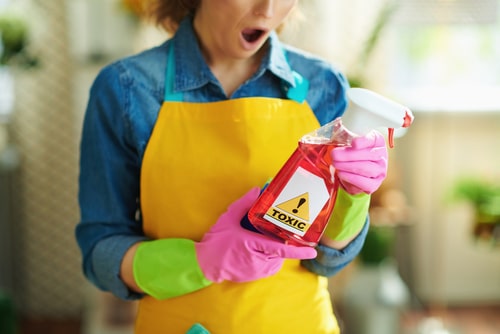The majority of commercially-produced household cleaning products have toxic ingredients that have been linked to cancer, allergies, reproductive disruption, asthma, neurotoxicity, and more. When we use cleaning products in our homes, they are absorbed through our skin and airways. It makes sense, then, to be extra choosy when it comes to what products we stock in our cleaning arsenal! Doing so will help reduce the toxic load we put on our bodies.
Ingredients to Avoid in Household Cleaning Products
DEGBE, also known as butoxydiglycol, belongs to a group of solvents known as glycol ethers commonly used in paints and cleaning products. Short term use in high amounts can lead to narcosis, pulmonary edema, and severe liver and kidney damage. In animal studies, inhalation of glycol ethers has been shown to cause reproductive and developmental effects.¹
DEGME, also known as methoxydiglycol, is another glycol ether that has been identified by the United Nations Economic Commission as being “suspected of damaging the unborn child.” This cleaner can contain toxin levels that are 15 times higher than what is allowed in the European Union.²
Nonylphenol ethoxylates are known endocrine disruptors that are banned in the European Union. They are toxic to aquatic life, with studies indicating their significant effect on changing the reproductive anatomy of fish.³
Quaternary ammonium compounds are a class of compounds that exhibit anti-microbial and anti-static qualities, making them a popular choice for household cleaning products, disinfectants, and laundry products. But these compounds are also known for causing asthmatic problems and reproductive problems, with one study finding they can cause neural tube defects in rodents.⁴
Do Your Research
The ingredients listed above are just a small handful of hazardous toxins to avoid. Many people assume any risky chemicals would be listed on the product label, but it’s important to note there is no FDA regulation requiring cleaning supplies to list ingredients. Some cleaners contain over 100 ingredients, few of which make it to the label. It’s also important to know that fragrance ingredients are not required to be identified. If you see “fragrance” listed on a label, that is likely a code word for a long list of chemicals
The Environmental Working Group has a robust online database that grades products from A to F based on many contributing factors regarding toxicity. Their database includes safety information for more than 2,500 products.⁵ We encourage you to use this guide as one of your reference points when determining product safety.
Don’t assume that a product is safe because it is “green” or “eco-friendly.” Companies will use slick marketing tactics to cover up the use of many chemicals in their products. Do your research to find alternatives from companies that are transparent about what exactly is in their cleaning products.
Don’t Over-Clean
In the quest to “eliminate all germs,” we actually run the risk of wiping out some of the most beneficial organisms designed to live in our digestive tracts. A lack of beneficial bacteria and gut flora alters normal metabolic and hormonal functions, which can lead to a rise in food allergies, leaky gut syndrome, digestive distress, and nutrient deficiencies.
The scientific theory called the “hygiene hypothesis” suggests that so many children are suffering from allergies, asthma, and other autoimmune conditions because we have scrubbed our environments free of the beneficial bacteria that help build a healthy immune system. Essentially, we have sanitized our way to a host of immune problems! It’s an interesting and worthwhile thought to consider.
A study published in the American Journal of Respiratory and Critical Care Medicine found that daily use of cleaning products can actually be as bad for women’s health as smoking a pack of cigarettes a day for 10-20 years.⁶ In short, over-cleaning and over-exposure to hazardous household cleaners is a recipe for increased health risks all around.
Healthy Household Cleaner Alternatives
Try these non-toxic alternatives when cleaning your home:
- Vinegar and water: Use a 1:1 ratio of water to vinegar and store it in a spray bottle. You can use this on sinks, countertops, bathrooms, or anywhere you would use a typical all-purpose cleaner. Vinegar cuts through grease nicely, which makes it a great option to use in the kitchen. (Just be sure to avoid using vinegar on hardwood floors, natural stone, marble, or granite.)
- Baking soda: Baking soda is an excellent cleaner and deodorizer. It pairs well with vinegar to clean and remove clogs, mineral build-up, and water residues. It also is mildly abrasive, so works well for jobs that need a little more scrubbing power.
- Natural soap and water: Combine a few drops of natural soap with warm water for the original all-purpose cleaner! Use soap and water followed by a simple warm water rinse for mopping floors, cleaning countertops, wiping glass or mirrors, and washing vehicles.
- Essential oils: Many essential oils have antibacterial and antimicrobial properties, so they make wonderful additions to a natural cleaning cabinet. Lemon oil is excellent for removing adhesive residues and freshening sinks. Cinnamon bark and clove oil are natural disinfectants. Citrus oils and eucalyptus act as air purifiers and fresheners when diffused.
- Antibacterial cloths: In microfiber cloths such as Norwex, the fabric is woven with silver that gives it antibacterial properties. Silver has been found to be effective in preventing infection and cross-contamination in the home and also in hospitals. Use these cloths for wiping surfaces instead of rags or paper towels.
Don’t underestimate the power of natural cleaners to get the job done. There are many effective options that are safer and easier to use than chemical cleaners. By switching to non-toxic options, you’ll be reducing your family’s toxic exposure and protecting your health while still creating a sparkling-clean home!
A Wellness Way Article. For more information visit: https://www.thewellnessway.com
References:
¹https://www.epa.gov/sites/production/files/2016-09/documents/glycol-ethers.pdf
²https://www.thewellnessway.com/cleaning/
³https://www.sciencedirect.com/science/article/abs/pii/S0013935198939457
⁴https://onlinelibrary.wiley.com/doi/epdf/10.1002/bdr2.1064
⁵https://www.ewg.org/guides/cleaners/
⁶https://www.atsjournals.org/doi/full/10.1164/rccm.201706-1311OC


